Abstract
A set of 86 bacterial cultures, including 30 strains of Vibrio cholerae, 35 strains of V. parahaemolyticus, and 21 representative strains of Pseudomonas, Spirillum, Achromobacter, Arthrobacter, and marine Vibrio species were tested for a total of 200 characteristics. Morphological, physiological, and biochemical characteristics were included in the analysis. Overall deoxyribonucleic acid (DNA) base compositions and ultrastructure, under the electron microscope, were also examined. The taxonomic data were analyzed by computer by using numerical taxonomy programs designed to sort and cluster strains related phenetically. The V. cholerae strains formed an homogeneous cluster, sharing overall S values of ≥75%. Two strains, V. cholerae NCTC 30 and NCTC 8042, did not fall into the V. cholerae species group when tested by the hypothetical median organism calculation. No separation of “classic” V. cholerae, El Tor vibrios, and nonagglutinable vibrios was observed. These all fell into a single, relatively homogeneous, V. cholerae species cluster. V. parahaemolyticus strains, excepting 5144, 5146, and 5162, designated members of the species V. alginolyticus, clustered at S ≥80%. Characteristics uniformly present in all the Vibrio species examined are given, as are also characteristics and frequency of occurrence for V. cholerae and V. parahaemolyticus. The clusters formed in the numerical taxonomy analyses revealed similar overall DNA base compositions, with the range for the Vibrio species of 40 to 48% guanine plus cytosine. Generic level of relationship of V. cholerae and V. parahaemolyticus is considered dubious. Intra- and intergroup relationships obtained from the numerical taxonomy studies showed highly significant correlation with DNA/DNA reassociation data.
Full text
PDF
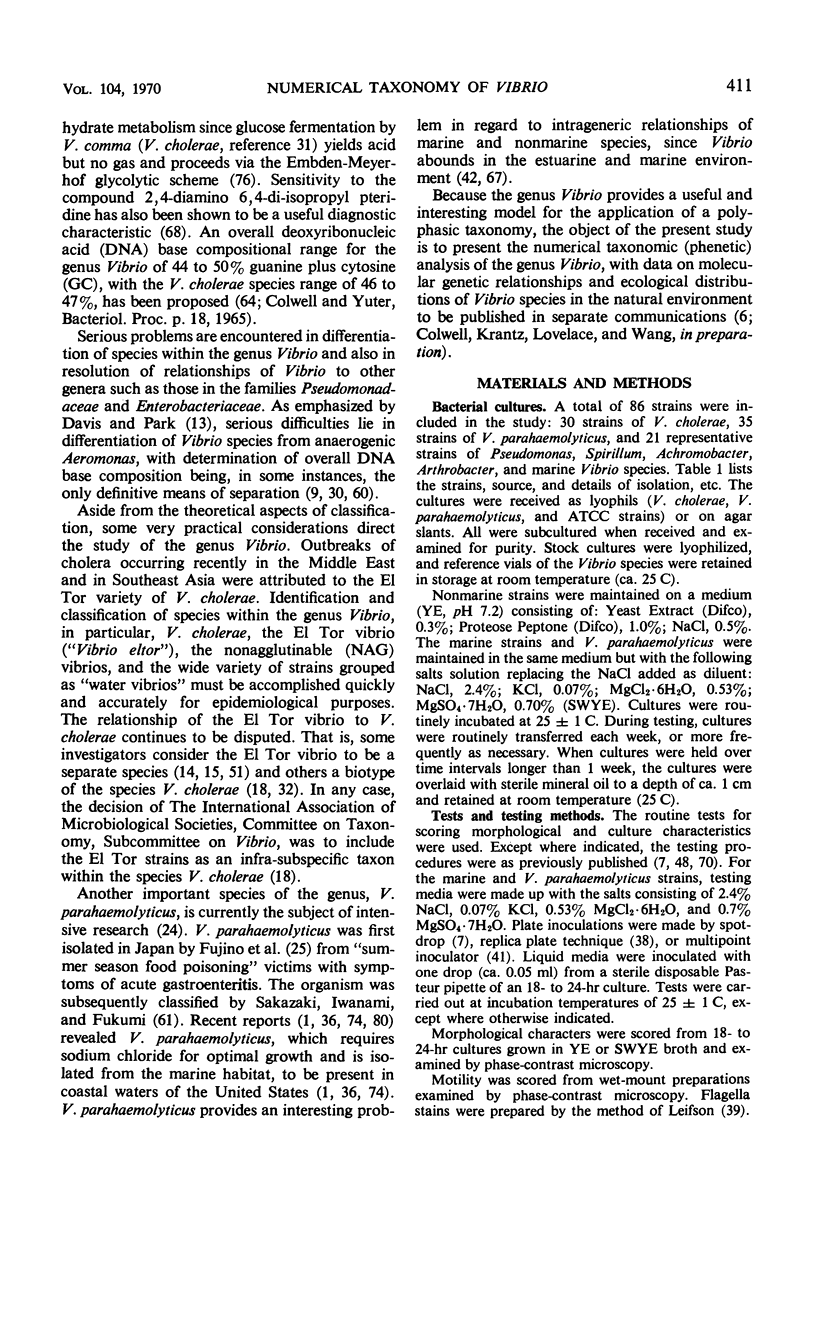






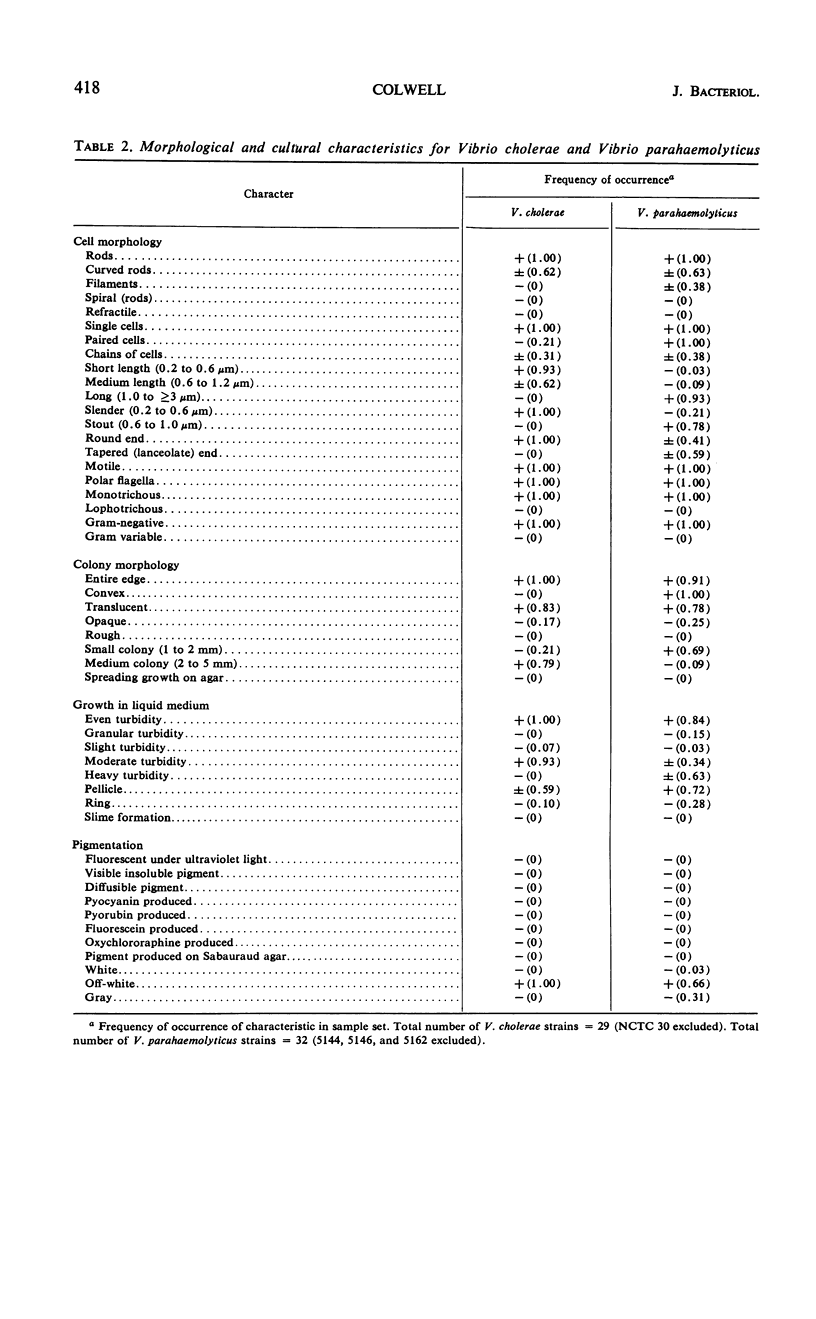


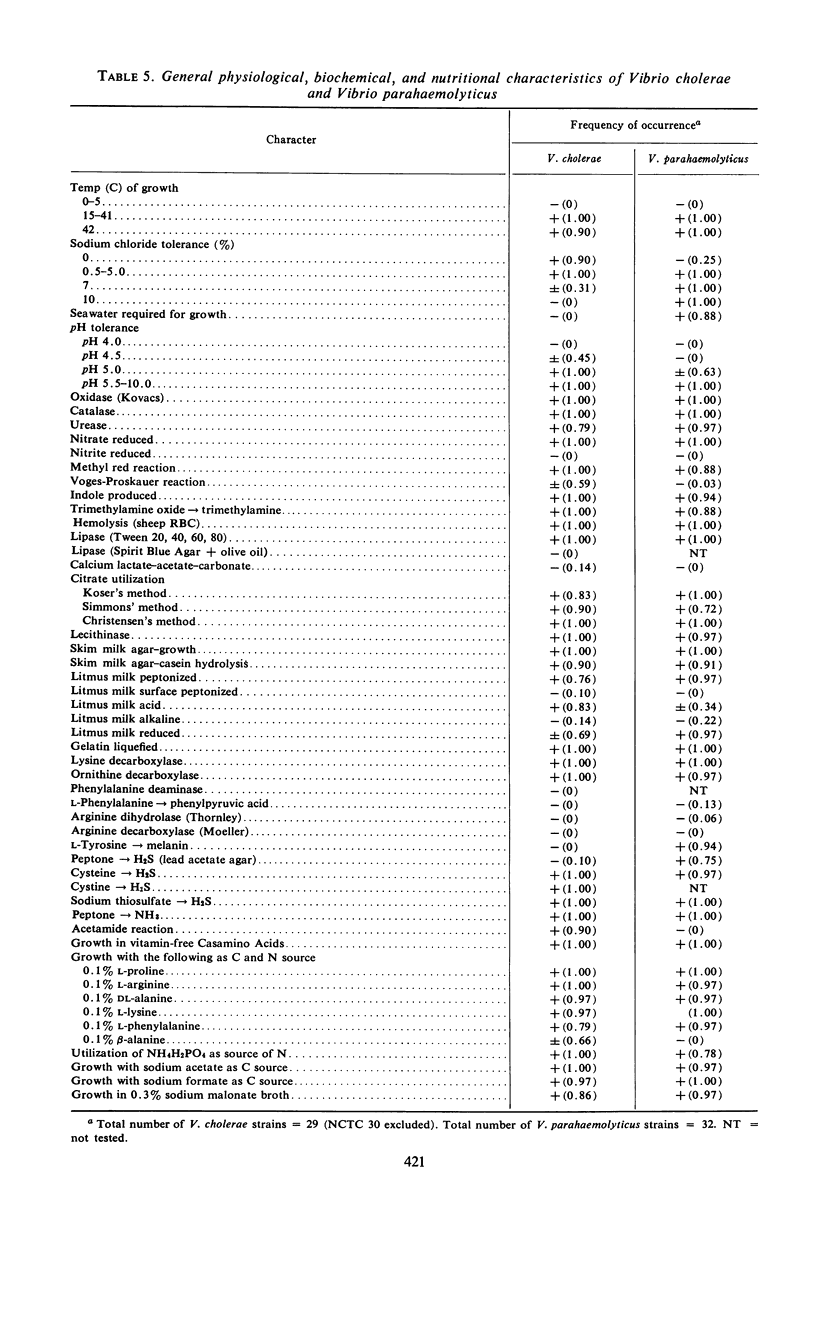






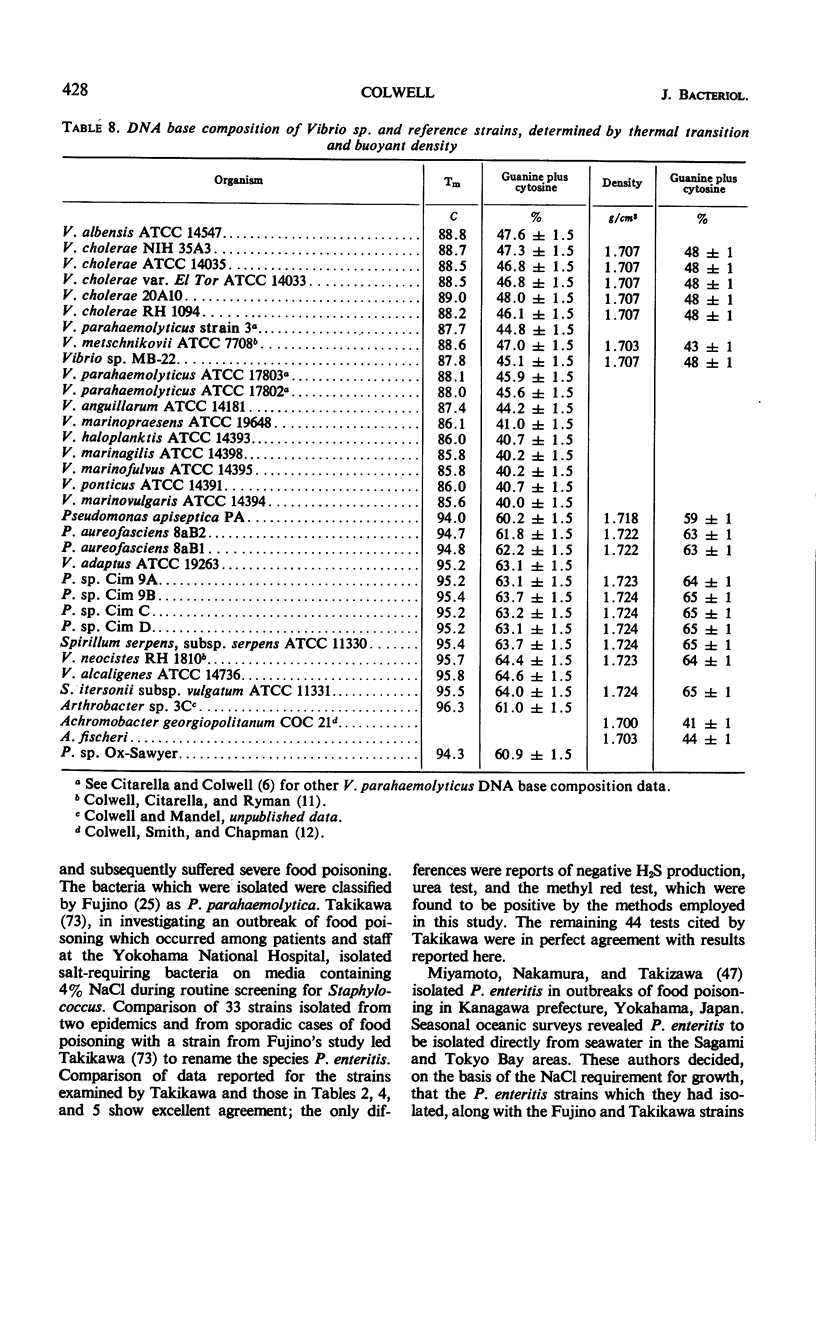




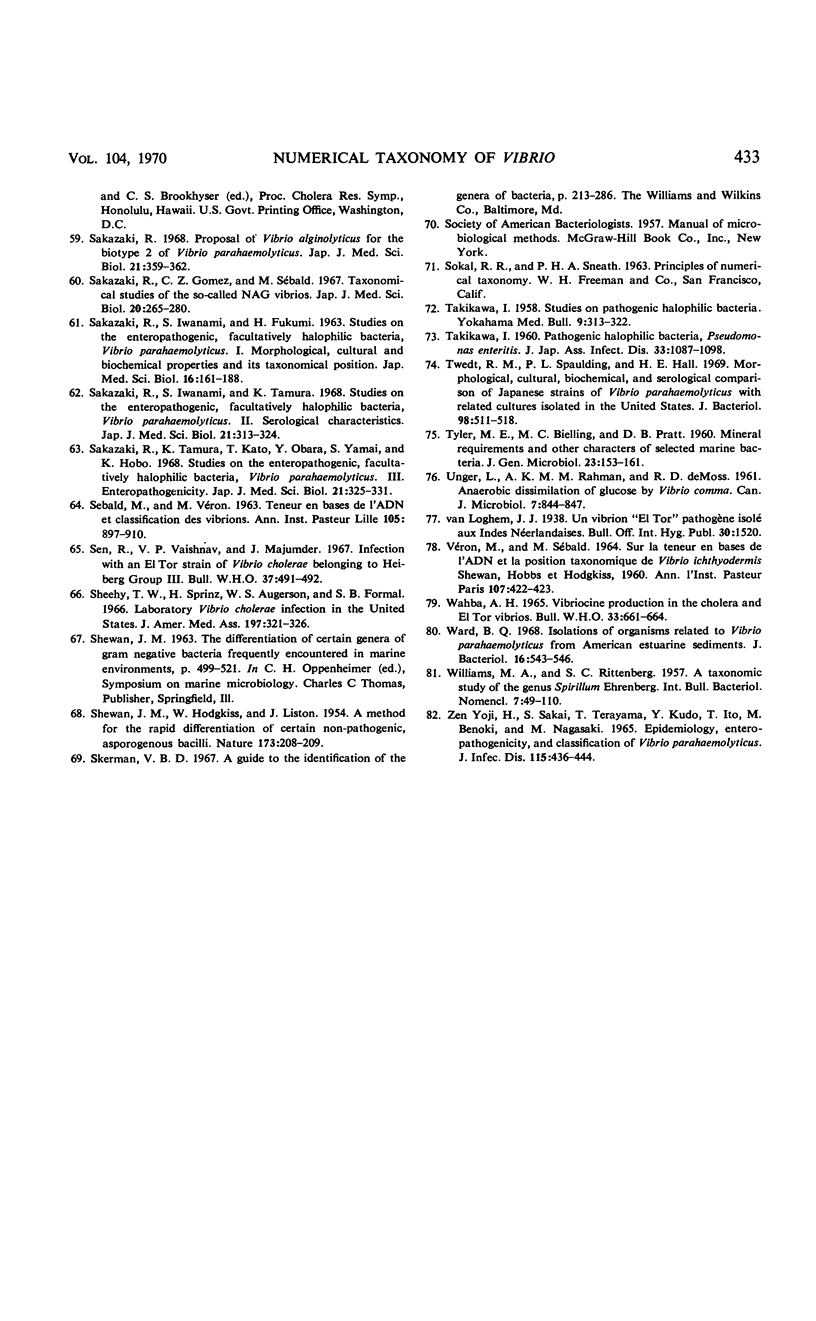
Images in this article
Selected References
These references are in PubMed. This may not be the complete list of references from this article.
- BHASKARAN K., GORRILL R. H. A study of antigenic variation in Vibrio cholerae. J Gen Microbiol. 1957 Jun;16(3):721–729. doi: 10.1099/00221287-16-3-721. [DOI] [PubMed] [Google Scholar]
- BHATTACHARJI L. M., BOSE B. FIELD AND LABORATORY STUDIES ON THE TRANSFORMATION OF THE V. CHOLERAE IN THE MAINTENANCE OF CHOLERA ENDEMICITY: A PRELIMINARY REPORT. Indian J Med Res. 1964 Aug;52:777–790. [PubMed] [Google Scholar]
- Baross J., Liston J. Isolation of vibrio parahaemolyticus from the Northwest Pacific. Nature. 1968 Mar 30;217(5135):1263–1264. doi: 10.1038/2171263a0. [DOI] [PubMed] [Google Scholar]
- COLWELL R. R. A STUDY OF FEATURES USED IN THE DIAGNOSIS OF PSEUDOMONAS AERUGINOSA. J Gen Microbiol. 1964 Nov;37:181–194. doi: 10.1099/00221287-37-2-181. [DOI] [PubMed] [Google Scholar]
- COLWELL R. R., MANDEL M. ADANSONIAN ANALYSIS AND DEOXYRIBONUCLEIC ACID BASE COMPOSITION OF SOME GRAM-NEGATIVE BACTERIA. J Bacteriol. 1964 Jun;87:1412–1422. doi: 10.1128/jb.87.6.1412-1422.1964. [DOI] [PMC free article] [PubMed] [Google Scholar]
- Citarella R. V., Colwell R. R. Polyphasic taxonomy of the genus Vibrio: polynucleotide sequence relationships among selected Vibrio species. J Bacteriol. 1970 Oct;104(1):434–442. doi: 10.1128/jb.104.1.434-442.1970. [DOI] [PMC free article] [PubMed] [Google Scholar]
- Colwell R. R., Adeyemo V. I., Kirtland H. H. Esterases and DNA base composition analysis of Vibrio cholerae and related vibrios. J Appl Bacteriol. 1968 Sep;31(3):323–335. doi: 10.1111/j.1365-2672.1968.tb00374.x. [DOI] [PubMed] [Google Scholar]
- Colwell R. R., Citarella R. V., Ryman I. Deoxyribonucleic acid base composition and Adansonian analysis of heterotrophic aerobic pseudomonads. J Bacteriol. 1965 Oct;90(4):1148–1149. doi: 10.1128/jb.90.4.1148-1149.1965. [DOI] [PMC free article] [PubMed] [Google Scholar]
- Colwell R. R., Smith E. J., Chapman G. B. Properties of a D-quinovosamine-producing Achromobacter. Can J Microbiol. 1968 Feb;14(2):165–171. doi: 10.1139/m68-027. [DOI] [PubMed] [Google Scholar]
- DAVIS G. H., PARK R. W. A taxonomic study of certain bacteria currently classified as Vibrio species. J Gen Microbiol. 1962 Jan;27:101–119. doi: 10.1099/00221287-27-1-101. [DOI] [PubMed] [Google Scholar]
- FEELEY J. C. CLASSIFICATION OF VIBRIO CHOLERAE (VIBRIO COMMA), INCLUDING EL TOR VIBRIOS, BY INFRASUBSPECIFIC CHARACTERISTICS. J Bacteriol. 1965 Mar;89:665–670. doi: 10.1128/jb.89.3.665-670.1965. [DOI] [PMC free article] [PubMed] [Google Scholar]
- FEELEY J. C., PITTMAN M. Studies on the haemolytic activity of El Tor vibrios. Bull World Health Organ. 1963;28(3):347–356. [PMC free article] [PubMed] [Google Scholar]
- FELSENFELD O. PRESENT STATUS OF THE EL TOR VIBRIO PROBLEM. Bacteriol Rev. 1964 Mar;28:72–86. doi: 10.1128/br.28.1.72-86.1964. [DOI] [PMC free article] [PubMed] [Google Scholar]
- Felsenfeld O. A review of recent trends in cholera research and control. With an annex on the isolation and identification of cholera vibrios. Bull World Health Organ. 1966;34(2):161–195. [PMC free article] [PubMed] [Google Scholar]
- Felter R. A., Colwell R. R., Chapman G. B. Morphology and round body fermation in Vibrio marinus. J Bacteriol. 1969 Jul;99(1):326–335. doi: 10.1128/jb.99.1.326-335.1969. [DOI] [PMC free article] [PubMed] [Google Scholar]
- Fujino T., Miwatani T., Yasuda J., Kondo M., Takeda Y., Akita Y., Kotera K., Okada M., Nishimune H., Shimizu Y. Taxonomic studies on the bacterial strains isolated from cases of "shirasu" food-poisoning (Pasteurella parahaemolytica) and related microorganisms. Biken J. 1965 Jun;8(2):63–71. [PubMed] [Google Scholar]
- Gangarosa E. J., Bennett J. V., Boring J. R., 3rd Differentiation between vibrio cholerae and Vibrio cholerae biotype El Tor by the polymyxin B disc test: comparative results with TCBS, Monsur's, Mueller-Hinton and nutrient agar media. Bull World Health Organ. 1967;36(6):987–990. [PMC free article] [PubMed] [Google Scholar]
- HUGH R., LEIFSON E. The taxonomic significance of fermentative versus oxidative metabolism of carbohydrates by various gram negative bacteria. J Bacteriol. 1953 Jul;66(1):24–26. doi: 10.1128/jb.66.1.24-26.1953. [DOI] [PMC free article] [PubMed] [Google Scholar]
- Hanaoka M., Kato Y., Amano T. Complementary examination of DNA'S among Vibrio species. Biken J. 1969 Sep;12(3):181–185. [PubMed] [Google Scholar]
- Hill L. R. An index to deoxyribonucleic acid base compositions of bacterial species. J Gen Microbiol. 1966 Sep;44(3):419–437. doi: 10.1099/00221287-44-3-419. [DOI] [PubMed] [Google Scholar]
- Krantz G. E., Colwell R. R., Lovelace E. Vibrio parahaemolyticus from the blue crab Callinectes sapidus in Chesapeake Bay. Science. 1969 Jun 13;164(3885):1286–1287. doi: 10.1126/science.164.3885.1286. [DOI] [PubMed] [Google Scholar]
- LANDERKIN G. B., KATZNELSON H. Organisms associated with septicemia in the honeybee, Apis mellifera. Can J Microbiol. 1959 Apr;5(2):169–172. doi: 10.1139/m59-021. [DOI] [PubMed] [Google Scholar]
- LEDERBERG J., LEDERBERG E. M. Replica plating and indirect selection of bacterial mutants. J Bacteriol. 1952 Mar;63(3):399–406. doi: 10.1128/jb.63.3.399-406.1952. [DOI] [PMC free article] [PubMed] [Google Scholar]
- LISTON J., WIEBE W., COLWELL R. R. QUANTITATIVE APPROACH TO THE STUDY OF BACTERIAL SPECIES. J Bacteriol. 1963 May;85:1061–1070. doi: 10.1128/jb.85.5.1061-1070.1963. [DOI] [PMC free article] [PubMed] [Google Scholar]
- Lovelace T. E., Colwell R. R. A multipoint inoculator for petri dishes. Appl Microbiol. 1968 Jun;16(6):944–945. doi: 10.1128/am.16.6.944-945.1968. [DOI] [PMC free article] [PubMed] [Google Scholar]
- MARMUR J., DOTY P. Determination of the base composition of deoxyribonucleic acid from its thermal denaturation temperature. J Mol Biol. 1962 Jul;5:109–118. doi: 10.1016/s0022-2836(62)80066-7. [DOI] [PubMed] [Google Scholar]
- MCINTYRE O. R., FEELEY J. C., GREENOUGH W. B., 3rd, BENENSON A. S., HASSAN S. I., SAAD A. DIARRHEA CAUSED BY NON-CHOLERA VIBRIOS. Am J Trop Med Hyg. 1965 May;14:412–418. doi: 10.4269/ajtmh.1965.14.412. [DOI] [PubMed] [Google Scholar]
- MONSUR K. A., RIZVI S. S., HUQ M. I., BENENSON A. S. EFFECT OF MUKERJEE'S GROUP IV PHAGE ON EL TOR VIBRIOS. Bull World Health Organ. 1965;32:211–216. [PMC free article] [PubMed] [Google Scholar]
- MUKERJEE S., ROY U. K. The vibrios of the recent choleralike outbreak in Hong Kong. Br Med J. 1962 Mar 10;1(5279):685–687. doi: 10.1136/bmj.1.5279.685. [DOI] [PMC free article] [PubMed] [Google Scholar]
- McIntyre O. R., Feeley J. C. Characteristics of non-cholera Vibrios isolated from cases of human diarrhoea. Bull World Health Organ. 1965;32(5):627–632. [PMC free article] [PubMed] [Google Scholar]
- Moffett M. L., Colwell R. R. Adansonian analysis of the Rhizobiaceae. J Gen Microbiol. 1968 Apr;51(2):245–266. doi: 10.1099/00221287-51-2-245. [DOI] [PubMed] [Google Scholar]
- MØLLER V. Simplified tests for some amino acid decarboxylases and for the arginine dihydrolase system. Acta Pathol Microbiol Scand. 1955;36(2):158–172. doi: 10.1111/j.1699-0463.1955.tb04583.x. [DOI] [PubMed] [Google Scholar]
- PITTMAN M., FEELEY J. C. Protective activity of cholera vaccines against E1 Tor cholera vibrios. Bull World Health Organ. 1963;28(3):379–383. [PMC free article] [PubMed] [Google Scholar]
- POLLITZER R., SWAROOP S., BURROWS W. Cholera. Monogr Ser World Health Organ. 1959;58(43):1001–1019. [PubMed] [Google Scholar]
- Pesigan T. P., Gomez C. Z., Gaetos D., Barua D. Variants of agglutinable vibrios in the Philippines. Bull World Health Organ. 1967;37(5):795–797. [PMC free article] [PubMed] [Google Scholar]
- Rizvi S., Benenson A. S. Phage resistance in Vibrio cholerae. Bull World Health Organ. 1966;35(5):675–680. [PMC free article] [PubMed] [Google Scholar]
- SAKAZAKI R., IWANAMI S., FUKUMI H. STUDIES ON THE ENTEROPATHOGENIC, FACULTATIVELY HALOPHILIC BACTERIA, VIBRIO PARAHAEMOLYTICUS. I. MORPHOLOGICAL, CULTURAL AND BIOCHEMICAL PROPERTIES AND ITS TAXONOMICAL POSITION. Jpn J Med Sci Biol. 1963 Aug;16:161–188. doi: 10.7883/yoken1952.16.161. [DOI] [PubMed] [Google Scholar]
- SEBALD M., VERON M. TENEUR EN BASES DE L'ADN ET CLASSIFICATION DES VIBRIONS. Ann Inst Pasteur (Paris) 1963 Nov;105:897–910. [PubMed] [Google Scholar]
- SHEWAN J. M., HODGKISS W. A method for the rapid differentiation of certain nonpathogenic, asporogenous bacilli. Nature. 1954 Jan 30;173(4396):208–209. doi: 10.1038/173208b0. [DOI] [PubMed] [Google Scholar]
- Sakazaki R., Iwanami S., Tamura K. Studies on the enteropathogenic, facultatively halophilic bacterium, Vibrio parahaemolyticus. II. Serological characteristics. Jpn J Med Sci Biol. 1968 Oct;21(5):313–324. doi: 10.7883/yoken1952.21.313. [DOI] [PubMed] [Google Scholar]
- Sakazaki R. Proposal of Vibrio alginolyticus for the biotype 2 of Vibrio parahaemolyticus. Jpn J Med Sci Biol. 1968 Oct;21(5):359–362. doi: 10.7883/yoken1952.21.359. [DOI] [PubMed] [Google Scholar]
- Sakazaki R., Tamura K., Kato T., Obara Y., Yamai S. Studies on the enteropathogenic, facultatively halophilic bacterium, Vibrio parahaemolyticus. 3. Enteropathogenicity. Jpn J Med Sci Biol. 1968 Oct;21(5):325–331. doi: 10.7883/yoken1952.21.325. [DOI] [PubMed] [Google Scholar]
- Sen R., Vaishnav V. P., Majumder J. Infection with an El Tor strain of Vibrio cholerae belonging to Heiberg group 3. Bull World Health Organ. 1967;37(3):491–492. [PMC free article] [PubMed] [Google Scholar]
- Sheehy T. W., Sprinz H., Augerson W. S., Formal S. B. Laboratory Vibrio cholerae infection in the United States. JAMA. 1966 Aug 1;197(5):321–326. [PubMed] [Google Scholar]
- TAKIKAWA I. Studies on pathogenic halophilic bacteria. Yokohama Med Bull. 1958 Oct;9(5):313–322. [PubMed] [Google Scholar]
- TYLER M. E., BIELLING M. C., PRATT D. B. Mineral requirements and other characters of selected marine bacteria. J Gen Microbiol. 1960 Aug;23:153–161. doi: 10.1099/00221287-23-1-153. [DOI] [PubMed] [Google Scholar]
- Twedt R. M., Spaulding P. L., Hall H. E. Morphological, cultural, biochemical, and serological comparison of Japanese strains of Vibrio parahemolyticus with related cultures isolated in the United States. J Bacteriol. 1969 May;98(2):511–518. doi: 10.1128/jb.98.2.511-518.1969. [DOI] [PMC free article] [PubMed] [Google Scholar]
- UNGER L., RAHMAN A. K., DEMOSS R. D. Anaerobic dissimilation of glucose by Vibrio comma. Can J Microbiol. 1961 Oct;7:844–847. doi: 10.1139/m61-105. [DOI] [PubMed] [Google Scholar]
- VERON M., SEBALD SUR LA TENEUR EN BASES DE L'ADN ET LA POSITION TAXONOMIQUE DE VIBRIO ICHTHYODERMIS SHEWAN, HOBBS ET HODGKISS, 1960. Ann Inst Pasteur (Paris) 1964 Sep;107:422–423. [PubMed] [Google Scholar]
- Wahba A. H. Vibriocine production in the cholera and El Tor vibrios. Bull World Health Organ. 1965;33(5):661–664. [PMC free article] [PubMed] [Google Scholar]
- Ward B. Q. Isolations of organisms related to Vibrio parahemolyticus from American estuarine sediments. Appl Microbiol. 1968 Mar;16(3):543–546. doi: 10.1128/am.16.3.543-546.1968. [DOI] [PMC free article] [PubMed] [Google Scholar]
- Zen-Yoji H., Sakai S., Terayama T., Kudo Y., Ito T., Benoki M., Nagasaki M. Epidemiology, enteropathogenicity, and classification of Vi.rio parahaemolyticus. J Infect Dis. 1965 Dec;115(5):436–444. doi: 10.1093/infdis/115.5.436. [DOI] [PubMed] [Google Scholar]
- el Shawi N., Thewaini A. J. Non-agglutinable vibrios isolated in the 1966 epidemic of cholera in Irag. Bull World Health Organ. 1969;40(1):163–166. [PMC free article] [PubMed] [Google Scholar]




